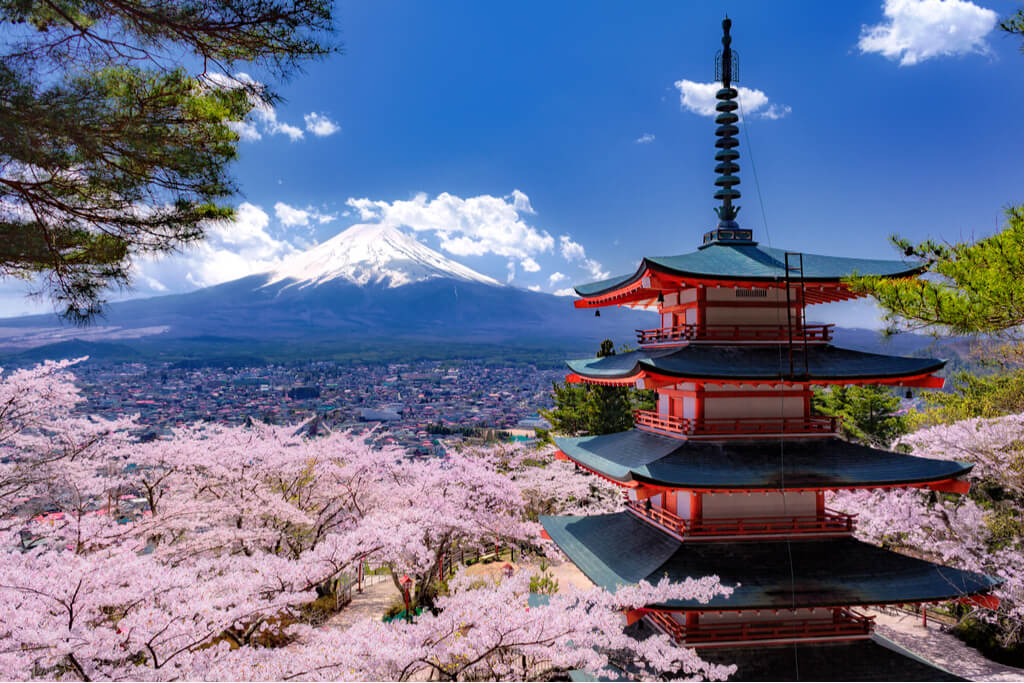Sakura (Japanese cherry blossom) is one of the most common Japanese words to spread worldwide. The word gained international popularity from Japanese anime, loved by many worldwide, and the many cherry trees gifted to other nations by the Japanese government.
Table of Contents
ToggleWhat is the Japanese Meaning of Cherry Blossom?
Well, sakura is the Japanese word for cherry blossoms, the small, delicate pink flowers seen during spring. Cherry blossoms are known as the flower of spring and have become unique, showing that spring is officially here. These flowers make spring one of the most beautiful and colorful seasons of the year in Japan. Let’s dive deep into the cultural importance and aspects of sakura season in Japan.

The Importance of Sakura in Japanese Culture
These tiny flowers that cover the city with their beautiful pink color are much more than just flowers. They are a national symbol related to Japanese culture. These cherry blossom trees do not produce any fruit. Instead, they bloom with beautiful flowers. Sakura trees only bloom once a year during the spring season; once in full bloom, they only last for around 10 days.
Even though cherry blossoms are seen in many other countries, sakura is an iconic image of Japan, with somei yoshino being the most common variety seen in Japan. It even attracts tourists from different countries to see gorgeous scenes during the sakura season.
Want to experience seasonal flavors like sakura as part of your tea time? Sakuraco sends seasonal and regional snacks and sweets right to your door.
What does sakura symbolize?
The sakura bloom marks the end of chilly winters and the beginning of the spring season. However, this is not the only sign of the sakura flowers. They bring in much more, including Japan’s rich history and cultural significance.

In the past, people used sakura to predict the planting and harvest seasons, indicating the right time for farmers to plant crops. Because of this, the onset of the sakura season is considered a sign of renewal in Japan.
For many Japanese people, sakura also symbolizes human mortality. The brief blooming period of sakura is often likened to the fleeting nature of life. The flowers exhibit beauty and brilliance at their peak, but eventually wither and become fragile, mirroring the cycle of human life. This serves as a reminder that life is both short and precious.
What else does sakura symbolize?
Japan also starts its fiscal and school year in April, during the cherry blossom season. Sakura, in this case, is a symbol of good luck and hope in Japanese culture.
Sakura season has a significant impact on Japan’s economy as well. It attracts a lot of tourism during this season as cherry blossom parks and gardens see a lot of international travelers. Also, Japanese brands come out with sakura snacks and products to celebrate the season, like the Starbucks sakura drink.
If you are in Japan at the right time, you can find a sakura version of almost anything you love, including clothes, cosmetics, snacks, chocolates, drinks, and more. The most exciting part of these products is the packaging. Brands focus more on the packaging to attract customers by using the season’s beauty. The huge popularity of sakura in Japan also brings in a lot of events, festivals, and activities. The whole of Japan and its people take up a full-on festive look, ready for a celebration.
Hanami (Cherry Blossom Festival) Culture
‘Hana’ refers to a flower, and ‘mi’ means to view. Put them together, and you get a flower-viewing event called Hanami. Hanami is not only famous, but it is also a significant event for Japanese people. It is basically like a picnic under the cherry blossom trees.

Hanami is a tradition started in the Imperial Court by Emperor Saga well over a thousand years ago. Japanese people picked up this activity as a picnic or party event to be enjoyed while viewing the flowers. It then became a tradition that friends and family celebrated every year, evolving into a main event where people can gather, celebrate the beauty of nature, and enjoy Japanese festival foods.
Although many Hanami festivals are happening across the country, they do not all happen simultaneously. The bloom starts in southern Japan and works northeast until it finishes in the northernmost part of Japan, Hokkaido. Because of this, sakura season is said to start in March and end in May, despite only lasting for a short time in each area.
Best Places to See Cherry Blossom Trees In Japan
If you are in Japan during the sakura season, you can see them in every nook and corner of the country. These beautiful pink flowers cover many streets, walkways, and rivers, adding beauty all over Japan. But a few parks and locations are particularly popular for the sakura bloom.

Ashino Park in Aomori has more than 2,300 cherry trees. You can even rent a rowboat to enjoy the fantastic view on its lake. Hirosaki Park in Aomori & Takada Park in Niigata is known for their beautiful views of the cherry blossoms at night. Shinjuku Gyoen in Tokyo, Mitsuike Koen in Yokohama, Chureito Pagoda in Fuji Five Lakes, and Miharu Takizakura in Fukushima are some attractive options that can be explored too.











2 Responses
Very interesting, well-explained, and beautifully pictured explanation. Gives me enhanced appreciation of the Japanese people, whom I respect, and aspects of their admirable culture. There is biblical-basis for likening fragile and fleeting human life, momentarily bright and beautiful, to Spring-growth of glorious delicate flowers–or for Japan, Sakura.
“As the Scriptures say, ‘People are like grass; their beauty is like a flower in the field.
The grass withers and the flower fades …'” — I-Peter 1:24 (NLT).
“As for man, his days are like grass; As a flower of the field, so he flourishes. For the wind passes over it, and it is gone, And its place remembers it no more.” — Psalm 103:15-16 (NKJV)
Says something very positive about the aesthetic nature of the Japanese nation (whose art, architecture and gardens I’ve long esteemed) that the exquisitely lovely Cherry Blossom Tree, for the Island people should figure so prominently! — At peace, the Japanese are an admirably great people.
The sakaru flower is very pretty and it was nice knowing the history of them. I now have some of the information that I think is great on my wall. Thank you for this 🌸🤍